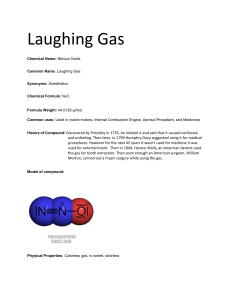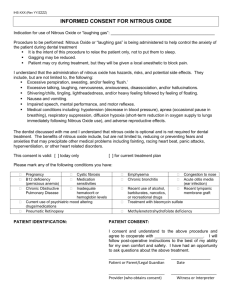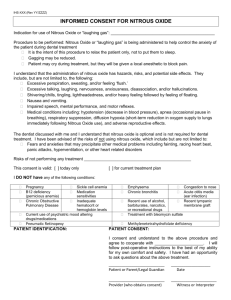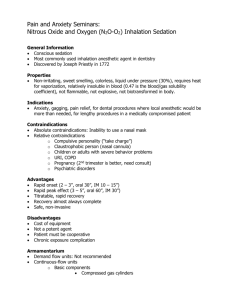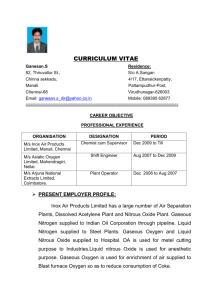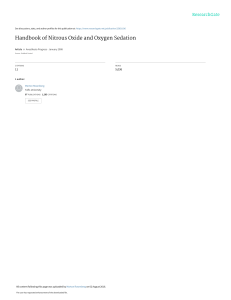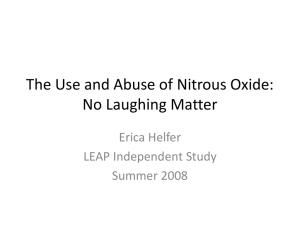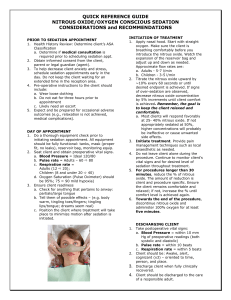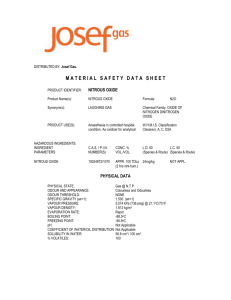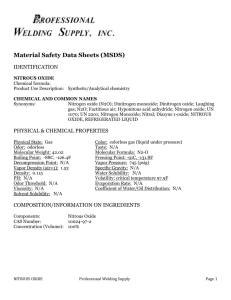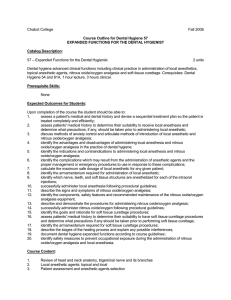Nitrous Oxide/Oxygen Conscious Sedation in the Pediatric Patient
advertisement
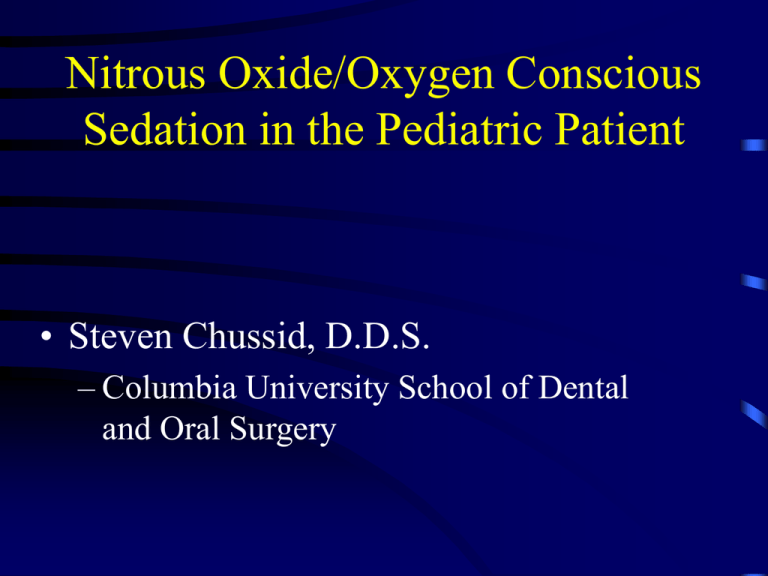
Nitrous Oxide/Oxygen Conscious Sedation in the Pediatric Patient • Steven Chussid, D.D.S. – Columbia University School of Dental and Oral Surgery Indications • • • • • • Reduce anxiety Increase pain threshold Suppress gag reflex Increase tolerance for longer appointments Eliminate need for sedative premedication Potentiate effects of sedative premedication Physical Properties of Nitrous Oxide • • • • A non-flammable, sweet-smelling gas Relatively insoluble Stable Stored in BLUE cylinders Chemical Properties • Nitrous oxide is inert • Quickly absorbed from the alveoli of the lungs and physically dissolved in the blood • Eliminated unchanged from the body • Gas is rapidly excreted from the lungs when the concentration gradient is reversed CNS Pharmacology • • • • • CNS depressant Weak anesthetic potency- MAC >100% Relatively potent analgesic Response to suggestion enhanced Cough reflex moderately suppressed Cardiovascular Effects • Parallels inhaling 100% oxygen • Slight decrease in heart rate • No evidence of increased myocardial irritability • No change to slight decrease in blood pressure Respiratory Effects • Slight stimulation-resulting in increased tidal volume • Sense of smell decreased Diffusion Hypoxia • Upon termination of nitrous oxide administration, the outpouring of of nitrous oxide into the lungs can dilute the amount of oxygen available to the patient • This danger is probably insignificant in healthy patients • However, it is recommended that the patient receive 100% oxygen for 3-5 minutes at the termination of N2O use to prevent possibility Gastrointestinal Effects • Nausea and Vomiting – Very low incidence – Usually, no special eating instructions prior to administration – Correlation with fluctuating concentrations of N2O? Relative Contraindications • • • • • • • COPD-bronchitis, emphysema URI Otitis Media Severe emotional disturbances Claustrophobia or irrational fear of “gas” Maxillofacial deformities or nasal obstructions Pregnant patients-especially in first trimester Advantages • • • • • • Rapid onset and recovery Ease of dose control (titration) Limited physiologic effects Analgesic Suppression of gag reflex Potentiation Disadvantages • Weak agent • Lack of patient acceptance • Inconvenience-when working on maxillary anterior teeth • Potential chronic toxicity • Potential for abuse • Necessary equipment • Potentiation Equipment • • • • • • Numerous types of machine available Fail-safe mechanism- minimum 20% O2 Audible or visual alarm if O2 interruption Flush lever Pin-indexed yoke system Gas cylinders color coded – Green-oxygen – Blue-nitrous oxide Safety Issues for Dental Personnel • Chronic exposure (>8 hrs. per week) – Increases in liver, kidney and neurologic diseases – Increase in spontaneous abortion – Increase in congenital abnormalities Minimizing Risk • Good scavenging system • Adequate circulation of room air • Limiting speech and mouth breathing of patient • Proper size nasal hood • ? Use in uncooperative child Potential for Abuse • A real concern in our profession • Secure safely • Common signs of abuse – Parasthesia or clumsiness of hands and legs – Loss of balance – Unsteady gait Patient Selection • • • • • Medical history and physical exam Parental consent Mild-moderate anxiety Strong gag reflex Capacity to be compliant and follow directions Administration • Prior to seating patient – Make sure equipment is set up and working properly – Select nasal hood of proper size – Have patient use restroom if necessary – Make sure you have an assistant! Administration-continued • Introduce child to equipment (slowly)-use tell, show, do • Make adjustments to ensure mask fits snugly but comfortably • Establish a total liter per minute of gases first with 100% O2 – 3-7 liters per minute depending on size of patient Administration-continued • Encourage the patient to breathe through nose – Light finger pressure under lower lip – Tap on nosepiece – Keep reminding them verbally • Slow vs. Rapid induction Administration-continued • During induction explain what the child might be feeling-use suggestion – – – – – – – Tingling feeling of hands and feet Numbness of lips and tongue Sensation of warmth Sensation of floating Feeling of heaviness Droning sounds Hearing distinct but distant Administration-continued • Watch patient for signs of proper level of sedation • Therapeutic nitrous oxide levels usually between 30%-50% • Do NOT exceed 50% • Vomiting is rare but watch for signs of nausea • If patient does vomit– – – – Don’t panic Turn head to side Suction mouth 100% O2 and complete procedure Administration-continued • Upon termination of procedure – Inhalation of 100% O2 for 3-5 minutes – Have child sit up in chair for several minutes Remember! • Nitrous oxide is not a substitute for traditional behavior management techniques • It should be considered an adjunct to aid in the management of the mild to moderately anxious patient who is capable of cooperating in the dental chair
